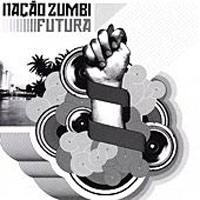
NAÇÃO ZUMBI
FUTURA (Circular Moves CIM7020)
Nação Zumbi's latest is a well-crafted pop album. It's closer to rock and roll than anything identifiably Brasilian. There's funky drum and bass aplenty (an acknowledgment to Tony Allen in the credits) and some "mothership" synthesizer in "Voyager," surf guitar and more "Frankenstein" effects in "Expresso da Eletrica Avenida." They seem to relish knob-twiddling effects (they must have found an old Moog at a garage sale) which tend to make each song a gimmick-laden collage obscuring the lyrics. The "singing" is mostly declaimed against the wall of noise: feedback, trap drums, meandering trumpet, wailing Moog.

LENINE
NA PRESSAO
A truly original and talented singer-songwriter from Brasil, Lenine has several albums out, but I am partial to this one from 1999. He starts out with an homage to Jackson Pandeiro, called "Jack Soul Brasiliera," a really catchy number, then follows with the hard-edged title track. But then he drops back for a delicate ballad, "Paciencia." His ballads are nicely interspersed with the meaner stuff. Most Brasilians sound off-key to me, but Lenine is right on the note. A well-crafted album, this could be the best thing to come out of Brasil since Pele. I caught his act on television while I was living in Pituba, Salvador da Bahia. He was sitting on the beach singing with his Martin guitar. During one number he forgot the words, stopped, asked if anyone had a cel phone, called his pal who had co-written the song and asked him for the lyrics. After he hung up, he resumed the song. It was unrehearsed but showed a great deal of professional aplomb. On the album he has lots of interesting effects, samples, loops, and unusual instruments, but his message comes through clear. There are no credits on the album, but a strong supporting cast of pounding bass, synthesizer, berimbau, backing vocalists and studio geeks.

AS MENINAS
XIBOM BOMBOM (Universal)
A Brasilian "girl group"-- one that is more situated in the "Sexy young babes" tradition rather than the "Chicks with attitude" camp -- is As Meninas, who come from Salvador da Bahia. Their big hit at Carnaval in March 2000 was "Xibom Bombom." Their new hit is "Samba de Nega Maluca," and both are on their album XIBOM BOMBOM. It's rhythmically complex and musically competent though it doesn't break any new ground. Like FESTA BRASIL it's a party record, or good for aerobics. Beto Jamaica from E O Tchan makes a guest appearance on "Feijao com arroz," an upbeat number in the tradition of "Food, glorious food." The similarity between this album and E O Tchan's work is explained by the presence of musical director Wesley Rangel and many of the same backing musicians.
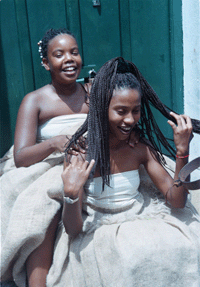
Dida prepare for carnaval 2001, photo AJ
DIDA BANDA FEMININA
A MULHER GERA O MUNDO
I had to go to Brasil in order to get into the music and now my buddy Deejay IJ makes fun of me every time some piece of Brasilian pop fluff gets stuck in my player. Currently it's "Filhos do Tempo" by Didá Banda Feminina, the last cut on their album A MULHER GERA O MUNDO. Didá is a Yoruba word which means "the power of youth." The all-female band was put together by Neguinho do Samba as a music school in Pelourinho, the ancient town of pastel stucco buildings and steep cobbled streets above the harbor in Salvador da Bahia. His goal was to create more opportunities for women in music, and the album yells "Girl Power!" from every track, but it's no Spice Girl concoction: this is an original, musically diverse and talented group with the heavy rhythmic underpinning of a dozen drums on every track. Think of a hybrid of samba and reggae with axé drumming instead of sly-an-robbie and you're part way there. What really grabs me, in this age of studio effects and synthi washes, is the horn arrangements for a full band of brass and woodwinds (flutes, oboe, clarinet, flugelhorn, trombones, trumpet, saxes). There is a little synthesizer but it doesn't intrude. In performance the banda wear face masks. It's not because of air pollution but a reference to a slave named Anastácia who was muzzled by the authorities for being an outspoken critic of society.
The climax of the album is the hit, "Filhos do Tempo (Children of Time)", a spare samba-reggae number with a mournful trombone solo by Fred Dantas in the tradition of Don Drummond's great work on songs like "Rain from the skies." There is also a superb clarinet part by Pedro Rabatto who throws baroque fills against the beat showing that he's more than passingly familiar with how J.S. Bach (the inventor of jazz) keeps things bubblin'. It's much more than bubblegum pop: "Filhos do Tempo" is a brilliantly arranged vignette that signposts a great new direction for Brasilian pop.

TRIBUTE TO LUIS GONZAGA
BAIÃO DE VIRAMUNDO (Stern's)
Most of us hadn't heard of Luis Gonzaga until after he died. He launched the 1991 Luaka Bop CD BRASIL CLASSICS 3: FORRO ETC, MUSIC OF THE NORTHEAST. This album brought the folk music of one of the remoter parts of Brasil to international attention. It was compared to country music; Gonzaga, one of its biggest stars, dressed in flashy cowboy clothes and had a following there akin to that of Hank Williams in the USA. With a stinging guitar backing up his accordion lead on his hit "O fole roncou," he blasted into gringo consciousness. A bustling triangle added a memorable pulse (who needs a drum machine, it insisted). Other than the two hits by Jackson do Pandeiro, the Luis Gonzaga tracks were the stand-out of that compilation. Now a decade after his death comes BAIÃO DE VIRAMUNDO, a tribute album by various artists on the Sterns label.
Gonzaga made it the hard way. He fled to the bright lights of Rio as soon as he could and labored away at his music in bars and bordellos until he won a song competition that was broadcast on the radio. He endured ridicule for his garb, including the leather halfmoon cowboy hat of his homeland, but his popularity was boosted by the many expatriates from the northeast who idolised him. He took the traditional music and created a style he called Baião (imagine a blend of ska and polka!). And now the hick is hip. Youngsters who wouldn't be caught dead near an accordion or playing anything in a 2/4 beat are digging his sounds as this new compilation attests.
"O Fole Ronco" by Naçao Zumbi uses a sample from the opening riff of the original, then goes into outer space with echoey vocals, a hard rock drummer & a guitarist with a lot of effects toys womping away. In addition there's what sounds like a Moog synthesizer adding some zoops and woops. There's funk in Andrea Marquee's "Que nem jilo," punk from Sheik Tosado, reggae, electronic dub, and jazz. I know Deejay IJ will laugh at me for digging this but as he knows, I wrote off Brazilian music as pop pablum until I went there in 1999 and now I'm planning my third trip back. It gets under your skin.
My other favorite track is "Minha Fulô" performed by Comadre Florzinha (a seemingly all-woman band). There's a lot to explore on this album, definitely one to check out if you're interested in new directions for Brazilian music.
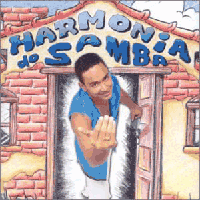
HARMONIA DO SAMBA
A CASA DO HARMONIA (Abril music 2001)
Some music is very specific to a time and place. Particularly when you are traveling and removed from your expectations as well as your own music (unless you are one of those foolish travelers that takes a Walkman or i-pod and shuts out the possibility). Some people return from vacation totally in love with the local music they heard and can't comprehend why it isn't a global smash hit. If they ask my advice I say, You should have bought it there, or, Try contacting the consulate and see if someone will help you. I went through hoops trying to find Antony Santos' music in the USA after hearing him everywhere in the Dominican Republic. I finally found a very pricy CD in London.
Brasilian music is more widely available: it just takes forever to get here and, unless you know what's what, you are in the dark. From the packaging some of it looks scary: is it wishy washy samba? Is it Christian heavy metal? Who ARE these people?I can't really recommend this Harmonia album. It's fine and sounds more like them than their previous efforts, but this was a band that peaked before they even recorded. Their best effort was a live bootleg that appeared before carnaval in Salvador da Bahia in 2000. It was the rage. Now Harmonia have blanded into the ranks of the other Salvadorean party bands, their "Agora Mexe (Eta Quebradeira)" no different from, say, E O Tchan's variations on the same lyrics. Still, they have a charismatic singer, Xandy, and if you go to carnaval in Salvador, you'll end up buying this and feel the itch of sunburn everytime you hear it.
Like all pop albums however, there is also the need to skip over certain tracks before you get serious ear-worms listening to them. And be forewarned: the Herb Alpert brass section is in full effect on the ballads. But the scratchy cavaquinho is still on top of the mix, the bass punches with "swingueira," and -- ignoring the synthesizer -- there are some catchy choruses. Oh, but one more caveat. Remember that wretched Peter Frampton thing: "Oooh, baby I love the way"? Well, they finally got one of those Vocoder gadgets in Brasil and it ruins an already soggy ballad, "Parece Criança." This could make you really ill -- or you might just get hooked on it. Whatever happens, stop before the last cut, "Agradecemos a vocês (Thanks to you)," a wet christian whine which is beyond sodden.

JACKSON DO PANDEIRO
COMO TEM, ZÉ NA PARAIBA (PolyGram)
Jackson do Pandeiro is one Brazilian artist whose music I enjoy. It is acoustically based. He had a couple of hits in the '60s & early 70s, and in 1998 PolyGram put out his greatest hits: COMO TEM, ZÉ NA PARAIBA which starts with what I consider a blockbuster, "Sebastiana." The orchestration is simple: accordion, acoustic guitar, tambourine, drum and triangle! His "Chiclete com banana" which is re-recorded regularly is also the name of a young band. The lyrics are very amusing: "I'll take up bebop rather than samba, when Uncle Sam plays the tambourine ... when he learns to samba rather than rumba." It goes on with other slights against America and is hugely popular despite the eagerness with which Brazilians crave Coca-colonization. The title track is a funny song about Paraiba where, apparently, everyone is called Zé, which is short for José.
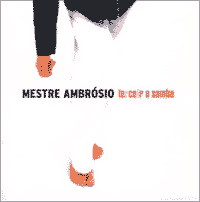
MESTRE AMBRÓSIO
TERCEIRO SAMBA (Sony Brasil)
From Brasil comes a satisfying new CD by Mestre Ambrósio: TERCEIRO SAMBA, recommended by the discerning Zeca Careca. The instruments are traditional but the production has an up-to-date sensibility to it. You sense they are listening to Peruvian, Dominican and Columbian music instead of reggae and American pop, perhaps because of their participation in music festivals in Slovenia, Holland and London, where they are bound to rub shoulders with some fly musical cats. I remember hearing an outstanding CD in an ersatz Mexican restaurant in Brasil and finding out it was by Carlos Vives, a Columbian artist whose self-produced album went platinum in Brasil. That was the most alive, authentic thing I had heard in ages.
This second offering from Mestre Ambrosio has a similar raw urgency to it: fiddle, bass, and percussion lay down an urgent groove with occasional forays from squeeze-box, triangle and some indigenous Brasilian percussion instruments. By the time the 8-button accordeon and acoustic guitar start to tangle in "Coqueiros," everything's percolating at an altogether higher level. This album really grew on me over a few weeks and I appreciate the care with which Ambrósio sought out traditional rhythms to showcase and augment. It's a glimpse of the potential inside Brasil today.
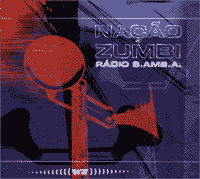
NAÇÃO ZUMBI
RADIO S.AMB.A (Stern's)
I'm more familiar with rock en español and funk as channeled through bands like Ozomatli and Los Amigos Invisibles, so the new Nação Zumbi CD, RADIO S.AMB.A is not so alien. Still, IJ is laughing at me for coming out of my purist shell and digging something so, well not exactly mainstream, but contemporary! They've been regrouping since the tragic death of their leader Chico Science, three years ago. While the album lacks his original stamp it has a lot going for it, both in musicality and diversity. Afrika Bambaataa appears on "Zumbi x zulu." Zumbi, from whom the band take their name, was a breakaway African slave who led a revolt in the jungles of the Northeast in the seventeenth century and jumped off a cliff to avoid capture. Also from Recife, the band are refugees from the concrete jungle of the twentieth century, and see their music as a form of rebellion. Despite the programming there is a still a martial intensity to the live drums, whistles, scrapers, tambourines, and rattles heard on this record. They challenge the notion of Brazilian music as easy-to-digest samba by taking indigenous forms from the Northeast and adding punk, funk, dub and rock. "We are going to rip the guts out of samba," sings Pixel 3000. There are American pop influences in the trap drums, the guitar and vocal delivery but the underpinning of maracatú and reggae serves the band well and leaves a lot of room for creative play.

OLODUM
PELA VIDA (Abril Music 8430001-2 2002)
Olodum's "Pela Vida" (Through life) kicks off with some strong melodies, good vocals and high energy: what you'd expect, but not totally rehashed. I've been trying to read some academic works in Portuguese lately so it's nice to have some bubblegum lyrics that are easy to digest. One of my favorite Portuguese words is "rainha" (Queen) because it's pronounced "Hyena," and gives the opposite image of what it's trying to convey. It occurs it the fourth song, whose chorus sounds like "Oh bye bye, oh bye bye" (Que vai vai) and which means "who goes, goes." Squeezebox enters on the third track ("Venha me amar" or "Come my love") giving a lyrical quality to the piece which floats over a wicked backbeat that shucks the dust off the subwoofer. Track 6, "Acima do sol (The Sun Above)" is another pleasant accordion-led track. The tracks are all three-minutes long and lean toward clustered voices harmonizing over the battery of drums, punctuated with well-arranged horn choruses. The synthesizer is not as oppressive as usual. The choruses are simple and strive to be anthemic: "Vem ser mais um amor | nesse carnaval (Come, be a lover again, this carnival)", only lapsing into total absurdity with the ambiguous English lyric "If Jesus Christ had been a black man there would be indifference the color of his purple skin." Now what exactly purple indifference signifies is lost on me. Maybe he means papal indifference? Country & Western meets reggae on "Manifesto pela paz (Manifesto for peace)" with slide guitar ("Olodum is for life, is for love, more than beauty. Greetings, God of Gods, Olodum, our little band, is for peace and faith"). The album ends with the national anthem, probably patriotic pride as Brazil had just won the World Cup when this album was recorded. The only good thing that can be said for it is that it's easier to sing than "The Star-spangled Banner."

PONTOS DE MACUMBA (Kardum, distributed by Harmonia Mundi)
Since I am spending Winter 2000 in Brasil, I brought along a new release titled PONTOS DE MACUMBA. It's a serious primer on Afro-Brasilian religious music, recorded in Rio de Janeiro in the '60s and '70s. The songs are mostly derived from the Yoruba religion and feature call-and-response vocals and polyrhythmic percussion like similar ritual music from slavery days in Cuba or Haiti, for example. I really appreciate CDs that come with detailed notes (particularly when they are in a legible point size). Reading them definitely enhances your enjoyment of the music. This CD is accompanied by a lavish booklet that is more than the track-listings: it includes a detailed discussion by Luigi Elongui about the African slave cults that preserved their religion in secrecy; he discusses the oft-bandied notion that the slaves "hid" their gods in the Catholic pantheon, and compares the different Candomblé cults derived mainly from Yoruba and Ewe sources.
Anyone familiar with John Farris Thompson's brilliant anthropological study FLASH OF THE SPIRIT (Random house, 1983) will be interested in the updated primer on the Orixas or Gods of Brazil and discussion of their diverse African origins written by Claire Lebovitz. She tells us that the Ibijis or Holy Twins (Geminis take note) love to guzzle coca-cola and beer and get up to all kinds of mischief. If you want them to protect your children you have to offer them many toys. That probably accounts for some of the GI Joe sales in Brazil.
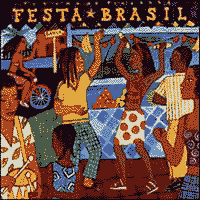
PUTUMAYO PRESENTS FESTA BRASIL (Putu 169-2)
I brought my pal Zeca the PUTUMAYO PRESENTS FESTA BRASIL CD because it has a song "about" him on it and he laughed uproariously at the liner note that says it includes samples of "Brasil's emerging reggae scene." Reggae is a very pervasive part of the culture here. Every time we'd hear hip-hop reggae, Brasilian dancehall or roots, or even cover versions of rocksteady tunes, he'd giggle, "Listen! I hear the sound of Brasil's emerging reggae scene!" I first heard my favourite song of 2000, "Filhos do Tempo" by Didá Banda Feminina, on the Putumayo compilation FESTA BRASIL, which highlights the samba-reggae movement as well as some new artists on the forró scene from Northeastern Brasil. A couple of big names are here -- Ivete Sangalo who emerged from Banda Eva, Gal Costa who does the perennial favorite "Chiclete com banana," in a great arrangement with surf guitar, and Chico César, a surreal singer/songwriter noted for his live shows -- but it's the lesser-knowns who make this album rock.
After a solid Wailers-like intro, Zeca Pagodinho's interpretation of "Severina Xique-Xique" brings up accordion and when his raspy voice comes in it sounds more like French or Italian café music. The girly chorus is so wispy that it makes quite an amusing contrast, but the song just coasts out on an endless repeat.
Ale Muniz's "Ie Mama" is another poppy entry rooted in reggae, with mouth percussion. Chico César's "Papo Cabeça," one of the best cuts on FESTA BRASIL, is also the lead cut on his debut Putumayo album. "Papo Cabeça" is an imaginative collection with a lot of variety that will be appreciated most by people who understand Portuguese. César plays acoustic guitar and brings a lot of pop influences to his work, like the Beatles, the Police and Jimmy Cliff. The title cut has been compared to "I am the Walrus" (more for it's nonsense poetry than any musical connection). There is a song mentioning Jimmy Cliff (who lives in Bahia) called "Fila" about how good César feels in his rimless hat! (If he didn't have such a wacky haircut he could walk around inconspicuously like the rest of us.) Bakhiti Kumalo (of GRACELAND fame) plays bass on several tracks. "Mama Africa," another reggae samba, and "Mand'ela" (with its punning title, which means "Tell her") both allude to the homeland. It's a pop album animated by strong rhythms that grows on you.
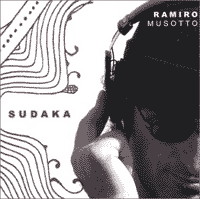
RAMIRO MUSSOTTO
SUDAKA (Fast Horse Recordings FH005 2003)
Some of the great names in Brasilian pop, like Gato Barbieri, Zeca Baleira, and Daniela Mercury, appear on this album which is a wonderful blend of hip hop, electronica and pop. It has a real "house" music edge to it, with drum programmes amping up from time to time, so it's not one I can play all the way through, but it is worthwhile. The berimbau is the lead instrument. The tracks are run through a flanger and underpinned by a really heavy dubby bass. Then "out" sax from Gato Barbieri kicks it up a notch. There are samples from some familiar places: Ile Aiye and Congolese pygmies being most notable. The guitarist cops a riff from Harmonia do Samba to add excitement to the opening cut "Caminho." The blend is very appealing, including such things as the "unidentified horse-drawn cart driver" and a bit of a movie soundtrack. It makes for a diverse and entertaining musical trip.
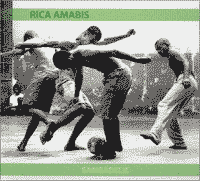
RICA AMABIS
SAMBADELIC (Stern's)
From reggae-samba to pop to hip-hop is not a big jump in world music and some new releases on Stern's showcase what's going on in the technoland of Rio and Sao Paulo. (One of the founders of Stern's moved from London to Brasil a few years ago and I was wondering if he'd get into music production there.)
Rica Amabis's SAMBADELIC is a highly contrived sound collage (he studied sound engineering in New York), reworking standards by Paulinho da Viola, Jorge Ben and Tim Maia. It's not exactly music to relax to, in fact it puts me on edge and I find it very annoying, but I did get into one cut, "Noel," that is the simplest thing on here. It samples an old record of a muted trumpet playing a Tin Pan Alley standard (it might be "I can't give you anything but love"). There's drum and bass and a Moog synthesizer learning to modulate pitch, and a looped fragment of voice going "co-co-co-co-corazao" (or "ha-ha-ha-ha-heart"). Its simplicity makes it appealing. It's so catchy that I'll probably keep the CD for this one song. The other stuff I leave to the techno hounds.
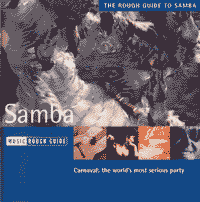
THE ROUGH GUIDE TO SAMBA (RGNET 1058CD)
THE ROUGH GUIDE TO SAMBA comes from the far end of the short-lived Portuguese empire. With its roots in Bahia, samba is now heard mainly in Rio de Janeiro, reaching a sonic peak in the five days before Ash Wednesday ("Quarta-feira de cinzas"). The spectacular carnaval procession in Rio is mostly a spectator sport with predictable winners and dirge-like anthems which are lyrically unconvincing. In Salvador the music has branched off into pagode and Axé with the former sounding more pop every year and the latter being drawn into the sphere of reggae. With all these influences now weighing into the balance of popular music in Brasil, samba is a last bastion of an indigenous sound. A new recording of the first recorded samba, "Pelo telefone," done here by Paulo Moura, shows the pleasant airiness of the typical samba melody over a gentle rhythm of tambourine and a double cowbell that is struck and clacked at the same time. Other new recordings of early sambas help present a clear picture of the evolution of the style as the bright, scratchy cavaquinho and the deep bass of the surdo drums come into play. I've resisted this music for a long time, but the Rough Guide makes sense and presents a palatable introduction to Brasil's most famous sound.
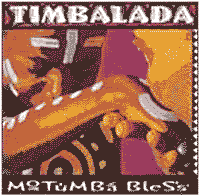
TIMBALADA
MOTUMBA BLESS (Abril Music 1030001-2 2002)
Timbalada, with their renowned singer Carlinhos Brown, succeed in being a reasonably well-integrated group and bloco. (I leave it to sociologists to explain why their white dancers have costumes and their black dancers are naked except for g-strings.) They have more instruments and more flexible and creative arrangements than Olodum and other Axé bands of renown, though the same underpinning sound of a strong battery of drums. But the result is more dissipated as they try on different effects and, overall, MOTUMBA BLESS lacks the head-banging insistency of Olodum's latest effort. Motumba is a Yoruba God about whom I know nothing. The song about her calls her mother of samba, and describes a ritual similar to that for Yemanja (white maize offerings, flowers to drop in the ocean). The chorus to this straight-ahead samba is in Yoruba. Most of the tracks have effects like sitar or synth grafted on, making them momentarily intriguing, but then the gimmick subsides and we get the same old stuff. I'd say skip this one.